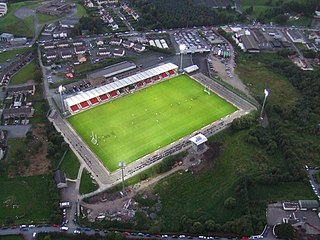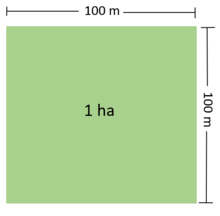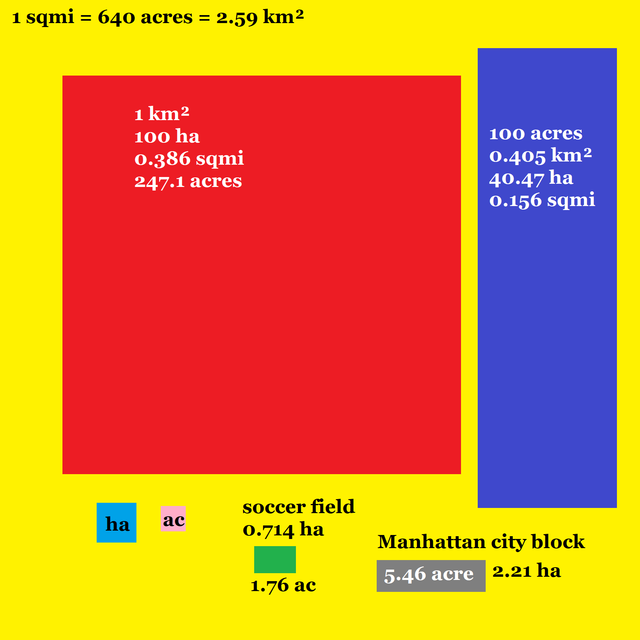The hectare (/ˈhɛktɛər, -tɑːr/; SI symbol: ha) is a non-SI metric unit of area equal to a square with 100-metre sides (1 hm2), that is, 10,000 square metres (10,000 m2), and is primarily used in the measurement of land. There are 100 hectares in one square kilometre. An acre is about 0.405 hectares and one hectare contains about 2.47 acres.

| hectare | |
|---|---|
 A visualisation of one hectare | |
| General information | |
| Unit system | Non-SI unit accepted for use with SI |
| Unit of | Area |
| Symbol | ha |
| Conversions | |
| 1 ha in ... | ... is equal to ... |
| SI base units: | 104 m2 |
| Imperial and US customary units | 11,960 sq yd 2.4711 acres |

In 1795, when the metric system was introduced, the are was defined as 100 square metres, or one square decametre, and the hectare ("hecto-" + "are") was thus 100 ares or 1⁄100 km2 (10,000 square metres). When the metric system was further rationalised in 1960, resulting in the International System of Units (SI), the are was not included as a recognised unit. The hectare, however, remains as a non-SI unit accepted for use with the SI and whose use is "expected to continue indefinitely". Though the dekare/decare daa (1,000 m2) and are (100 m2) are not officially "accepted for use", they are still used in some contexts.
Description
| Unit | SI |
|---|---|
| 1 ca | 1 m2 |
| 1 a | 100 m2 |
| 1 ha | 10,000 m2 |
| 100 ha | 1,000,000 m2 1 km2 |
| non-SI comparisons | |
| non-SI | metric |
| 0.3861 sq mi | 1 km2 |
| 2.471 acre | 1 ha |
| 107,639 sq ft | 1 ha |
| 1 sq mi | 259.0 ha |
| 1 acre | 0.4047 ha |

The hectare (/ˈhɛktɛər, -tɑːr/[2]), although not a unit of SI, is the only named unit of area that is accepted for use with SI units.[3] The name was coined in French, from the Latin ārea.[4] In practice the hectare is fully derived from the SI, being equivalent to a square hectometre. It is widely used throughout the world for the measurement of large areas of land,[5] and it is the legal unit of measure in domains concerned with land ownership, planning, and management, including law (land deeds), agriculture, forestry, and town planning throughout the European Union,[6] New Zealand and Australia (since 1970).[7][8] However, the United Kingdom,[9] the United States, Myanmar (Burma),[10][11] and to some extent Canada, use the acre instead of the hectare for measuring surface or land area.[citation needed]
Some countries that underwent a general conversion from traditional measurements to metric measurements (e.g. Canada) required a resurvey when units of measure in legal descriptions relating to land were converted to metric units.[citation needed] Others, such as South Africa, published conversion factors which were to be used particularly "when preparing consolidation diagrams by compilation".[12]
In many countries, metrification redefined or clarified existing measures in terms of metric units. The following legacy units of area have been redefined as being equal to one hectare:[13]
- Jerib (Persian: جریب) in Iran
- Djerib (Turkish: cerip) in Turkey[14]
- Gongqing (traditional Chinese: 公頃; simplified Chinese: 公顷; pinyin: gōngqǐng) in China
- Manzana in Argentina
- Bunder in the Netherlands (until 1937)[15][16]
In Mexico, land area measurements are commonly given as combinations of hectares, ares, and centiares.[17] These are commonly written separated by a dash; for example, 1-21-00.26 ha would mean 1 hectare, 21 ares, and 0.26 centiares (12,100.26 m2).
History
The metric system of measurement was first given a legal basis in 1795 by the French Revolutionary government. The law of 18 Germinal, Year III (7 April 1795) defined five units of measure:[18]
- The metre for length
- The are (100 m2) for area [of land]
- The stère (1 m3) for volume of stacked firewood[19]
- The litre (1 dm3) for volumes of liquid
- The gram for mass
In 1960, when the metric system was updated as the International System of Units (SI), the are did not receive international recognition. The International Committee for Weights and Measures (CIPM) makes no mention of the are in the 2019 edition of the SI brochure, but classifies the hectare as a "Non-SI unit accepted for use with the International System of Units".[20]
In 1972, the European Economic Community (EEC) passed directive 71/354/EEC,[21] which catalogued the units of measure that might be used within the Community. The units that were catalogued replicated the recommendations of the CGPM, supplemented by a few other units including the are (and implicitly the hectare) whose use was limited to the measurement of land.
Unit family

The names centiare, deciare, decare and hectare are derived by adding the standard metric prefixes to the original base unit of area, the are.
Decimilliare
The decimilliare (dma, sometimes seen in cadastre area evaluation of real estate plots) is 1⁄10,000 are or one square decimetre.[22] Such usage of a double prefix is non-standard. The decimilliare is (100 mm)2 or roughly a four-inch-by-four-inch square.
Centiare
Deciare
The deciare (rarely used) is ten square metres.[25]
Are
The are (/ɑːr/[26] or /ɛər/[27]) is a unit of area, equal to 100 square metres (10 m × 10 m), used for measuring land area. It was defined by older forms of the metric system, but is now outside the modern International System of Units (SI).[28] It is still commonly used in speech to measure real estate, in particular in Indonesia, India, and in various European countries.
In Russian and some other languages of the former Soviet Union, the are is called sotka (Russian: сотка: 'a hundred', i.e. 100 m2 or 1⁄100 hectare). It is used to describe the size of suburban dacha or allotment garden plots or small city parks where the hectare would be too large. Many Russian dachas are 6 ares in size (in Russian, шесть соток).
Decare
The decare or dekare (/ˈdɛkɑːr, -ɛər/) is derived from deca and are, and is equal to 10 ares or 1000 square metres. It is used in Norway[29] and in the former Ottoman areas of the Middle East and Bulgaria[30] as a measure of land area. The names of the older land measures of similar size are usually used, redefined as exactly one decare:
Conversions
| Unit name | Symbol | Multiple of preceding unit |
Fraction of succeeding unit |
Length of square side |
SI equivalents | British imperial/United States customary equivalents |
|---|---|---|---|---|---|---|
| centiare | ca | 0.1 da | 1 m | 1 m2 | 10.76391 sq ft | |
| deciare | da | 10 ca | 0.1 a | 3.1623 m | 10 m2 | 11.95990 sq yd |
| are | a[33] | 10 da | 0.1 daa | 10 m | 100 m2 | 3.95369 perches |
| decare | daa | 10 a | 0.1 ha | 31.623 m | 1000 m2 | 0.988422 roods |
| hectare | ha[5] | 10 daa | 0.01 km2 | 100 m | 10000 m2 | 2.47105 acres |
| square kilometre | km2 | 100 ha | 1000 m | 1000000 m2 | 0.386102 sq mi |

The most commonly used units are in bold.
One hectare is also equivalent to:
Unicode
The Unicode character U+33CA ㏊ SQUARE HA, in the CJK Compatibility block, is intended for compatibility with pre-existing East Asian character codes.[36] It is not intended for use in alphabetic contexts. U+3336 ㌶ SQUARE HEKUTAARU is a combination of ヘクタール (hekutāru), the Japanese translation of "hectare".
See also
References
External links
Wikiwand in your browser!
Seamless Wikipedia browsing. On steroids.
Every time you click a link to Wikipedia, Wiktionary or Wikiquote in your browser's search results, it will show the modern Wikiwand interface.
Wikiwand extension is a five stars, simple, with minimum permission required to keep your browsing private, safe and transparent.
